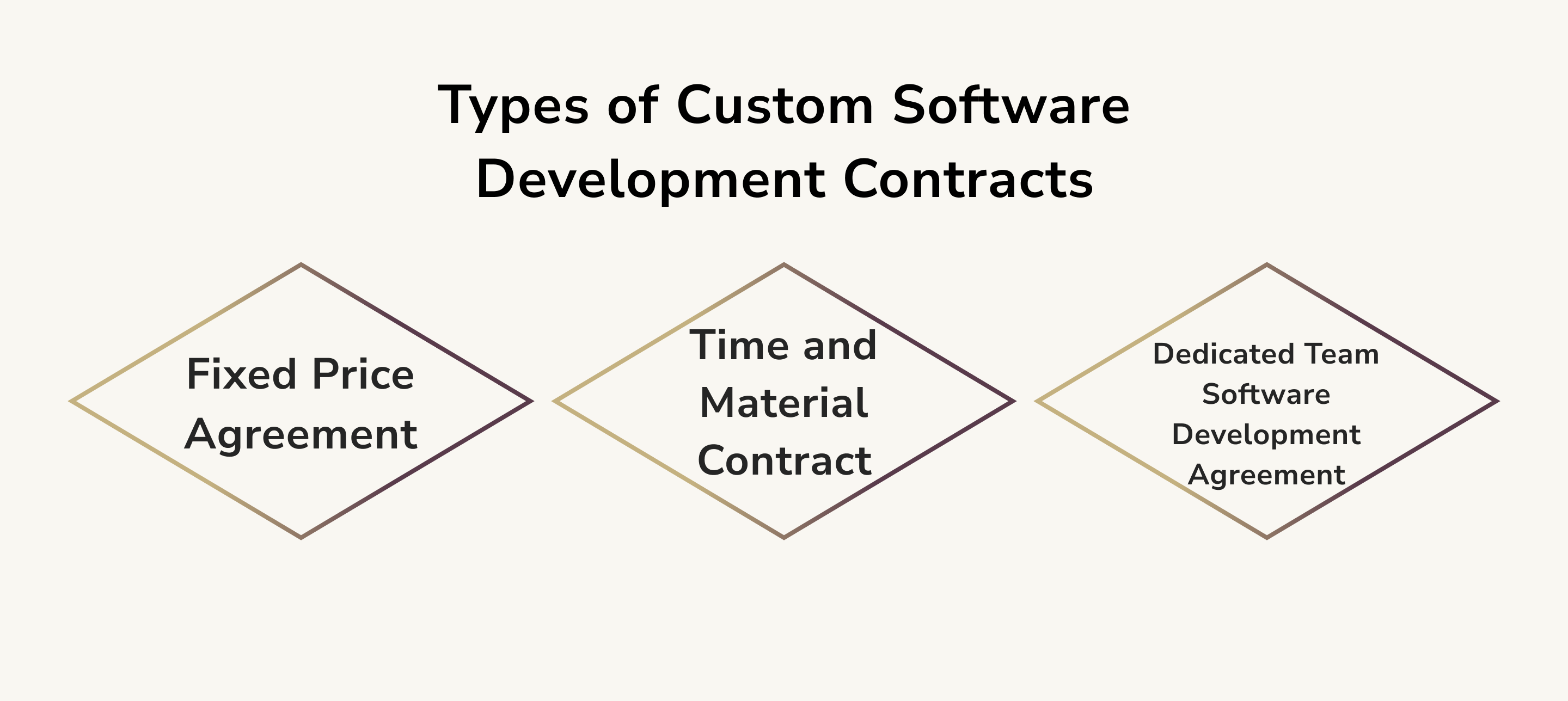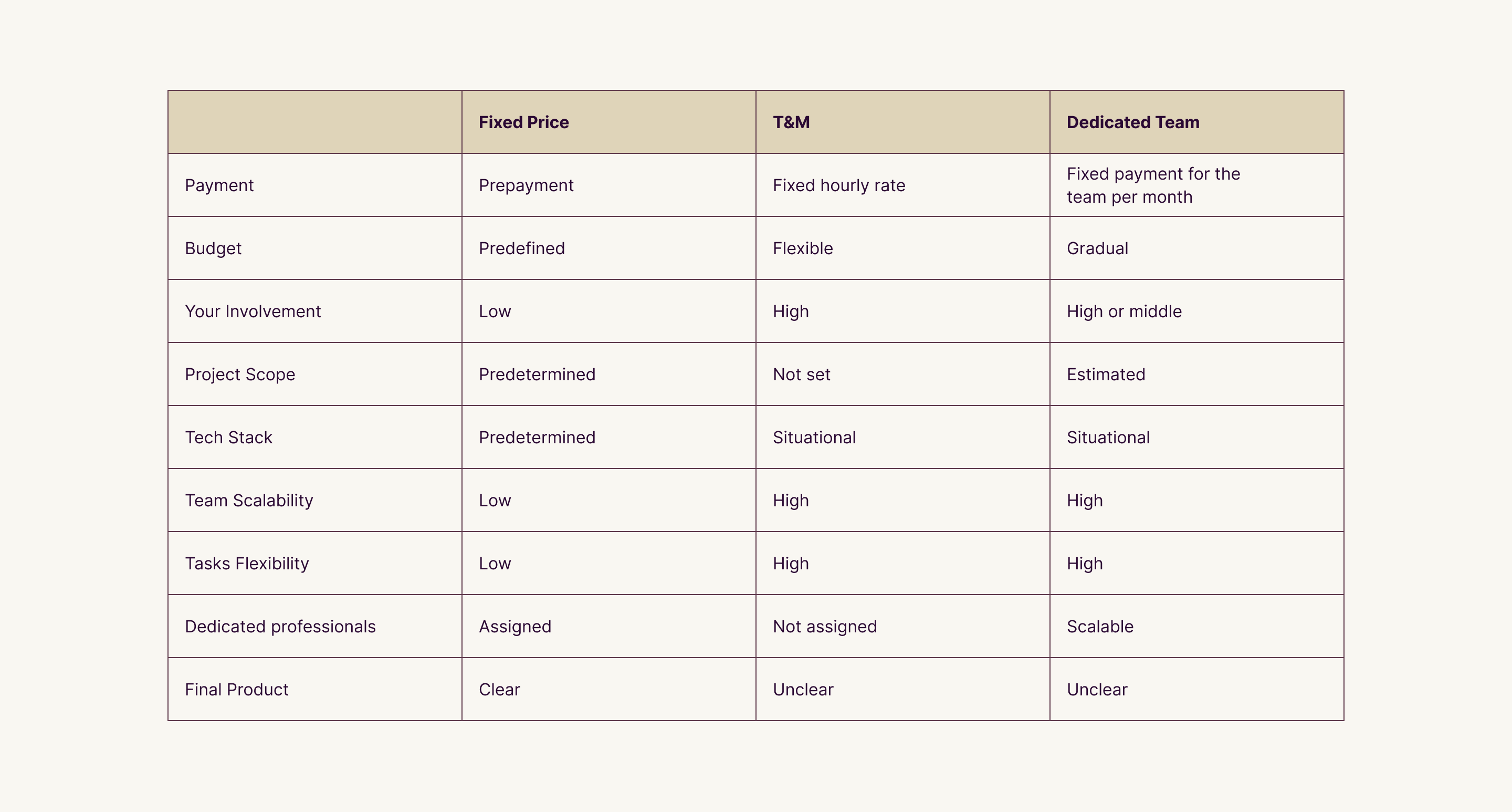What to Include in Custom Software Development Contract

Once you have an idea for a unique software solution that can boost your business, career, and the lives of people, you need to get started with it. The next step to take is to hire developers or find a software development partner.
We assume that your head is now boiling because of the thousands of questions. Who should you hire? How much will it cost? How to compose a contract and make it work? How much time will the development take?
All these questions can be confusing and overwhelming. But don’t worry, we have you secured and will answer all of these questions in a fast and straightforward manner.
Besides, the chaos in your head can be treated very simply by signing the right type of contract. As follows, a software development contract is an agreement that includes the client’s expectations, duration of the project and its estimated date of completion, warranties and conditions, intellectual property rights, compensation information, and many more.
A custom software development agreement gives you the ability to:
- track the progress of your long-awaited software solution
- make alterations on the go
- get regular reports
- communicate with the team
- free your mind from unnecessary thoughts on how to make everything real
- so much more
Still, if you wonder why this software development contract is so precious and valuable, here is the answer: it lets you know what you will pay for and what exactly you will get for your money. The agreement helps you discover the ins and outs of your solution development.
So, let’s discover which type of software development contract is a fit for you, shall we?
Types of Custom Software Development Contracts
There are three types of software development contracts, notably Fixed Price, Time and Material, and Dedicated Team agreements.
The mechanics of choosing the most suitable software development contract for your project is pretty easy. Your decision should be based on the duration of the project, your budget, and the scope of what you want to achieve in the end. Apart from these factors, it also depends on your extra preferences, like the project management model and intellectual property rights.
Yet, no matter which custom software development contract you choose, your project will be developed in the same stages: estimation, proposal, agreement, discovery phase, development, quality assurance, release, and maintenance.

So, let’s dive deeper into the perks of every type of contract.
Fixed Price Agreement
A little heads-up: fixed price software development contracts (which are also called fixed bid contracts or fixed sum contracts) are the best fit for projects that last up to two months and have clear and concise scope. It means that you have all the documentation, terms and conditions, and deadlines already set.
What is good about the fixed bid is that you’ll have the solution ready when you expect it. If you had in mind to receive your amazing software for the anniversary of your firm, it would be released on the day you planned. So, this type of custom software development contract holds no surprises regarding the timelines.
Yet, the requirements of the project are given at the very beginning of it so that you won’t have so much flexibility here. It also pertains to the technologies your software development partner will use for the solution. The usage of known tech stacks ensures that deadlines will be met. So, you will have time to prepare the bottle of champagne and be ready for the completion date.
As follows, we recommend you choose the fixed-price custom software development contact if your project:
- lasts up to two months
- has thoroughly documented requirements
- has a limited budget
- has an exact deadline
- can be developed with a tech stack your software development partner has used thousands of times
But don’t be in a hurry to sign the fixed bid contract and start work. You need to review the proposal first. It will include the final price and duration, terms and conditions, the details of the fixed bid contract, risk assessment along with risk mitigation plan, and the details of your cooperation (weekly or bi-weekly demo schedule, the way how you communicate with software engineers).
When you feel that you’re happy with all the conditions of the proposal, you can proceed with signing and starting the project. And remember, once the scope is agreed upon, you cannot change it.
So, let’s summarize the pros and cons of the fixed-price software development contract.
Pros
- All parties know exactly what has to be built.
- The software development partner assumes all the risk, and you are secure knowing that project will remain strictly within the agreed budget.
- It ensures increased communication and interaction points even before the project actually starts.
Cons
- Limited flexibility and inability to significantly change the project scope.
- If the communication goes wrong from the very beginning or the processes are not clearly laid out, it can be the biggest risk. Assuming all the risks for the project failure, the software development partner can change their behavior noticeably.
- The fixed-price contract is the hardest way to get the project started. It requires most of the work done correctly before you even begin the development.
If you’re not ready to cope with the cons of a fixed-price software development contract, another type of agreement may be right for you.
Time and Material Contract
If you’re not sure what functionality to include in your future solution and are open to ideas from the side, a time and material software development agreement is your bus stop.
Time and material contract (T&M) was initially created by software development providers to reduce their risks and increase development flexibility. In other words, the T&M type of contract foresees that you pay only for factual working time.
If transparency matters to you the most, then time and materials contracts are the best choices. It allows you to control the whole development process. You can add a new feature or extend the scope at any time.
From a T&M software development contract type, you get an opportunity to regularly chat with the development and design teams, prioritize the backlog, be flexible, and track weekly progress in Jira or during the weekly demos.
So, you can opt for signing a time and material agreement if your project:
- lasts between one and two months
- doesn’t have a vision of how your brand-new piece of software will look and function
- has the changeable requirements if more advantageous options are advised
- has a flexible budget
Just like with the fixed price software development agreement, you first need the proposal to start the ball rolling. In the proposal, you will find the estimated timelines, terms and conditions, risk assessment, mitigation plan, rates, and client’s rights. The client’s rights include regular communication with the team, access to Jira or other project management software, task prioritization, and tracking hours).
Now, let’s summarize the advantages and disadvantages of time and materials contracts.
Advantages
- The software development partner doesn’t cut corners and rush the development to have the solution ready as soon as possible.
- Less complicated to get the project started in comparison with the fixed price contract.
- It ensures bigger trust and open communication.
- You know what you’re paying for when you track hours and see demos.
Disadvantages
- You assume all the risk for the project's success.
- You cannot control the budget.
Dedicated Team Software Development Agreement
A dedicated team contract provides you with a product development team for long-term cooperation. The professionals are strictly chosen according to your requirements for their skillset and expertise.
What is more, this type of contract matches the large-scale projects that last more than three months. If you need flexibility and transparency, a dedicated team will give it to you. By participating in sync-ups and retrospectives, you keep the finger on the pulse.
As in the previous sections, review the checklist to decide whether you are in need of a dedicated team contract:
- your project will last more than three months
- you want to participate in the process and control the progress fully
- you’re flexible on budgeting
- your project has not a common functionality and requires additional research
- the project requires a team of full-time dedicated professionals
A dedicated team package grants you full access to the team’s work and project management software, the ability to prioritize tasks, plan sprints, participate in daily stand-ups, and the opportunity to communicate your vision directly with software engineers and designers.
The main perks of this type of software development contract are:
- Control over the product development process.
- Transparency and unlimited communication with all professionals.
- Flexibility to change or add new features at any time.
- Product development team is fully dedicated to your one project.
However, there are some drawbacks:
- You take a certain amount of responsibility for the project's success.
- You have to dedicate time to track the progress of the project and sometimes manage the team.
To make your choice of the right contract type, review the comparison table:

Essential Parts of Custom Software Development Contract
As we’re done with the types of software development contracts, it’s high time to speak about the key parts that have to be clarified. Undoubtedly, the agreements spell out what the final result will look like, what are the acceptance criteria, and how the whole collaboration will work for both sides. But there’s more to it!
Let’s dig deeper into the main points of your custom software development contract.
Liabilities
Contractual liability defines the legal conditions of your agreement. It regulates who will pay for any losses or damages and what would happen if intellectual rights are violated.
In addition, the liability clauses determine the conditions of the termination of the contract and the indemnification obligations of the contractor. In general, the liabilities part serves to secure both sides from failure. No one likes it, but it still happens. Besides, this part also helps you to map out the exit strategy.
Finally, contractual liability helps to regulate dispute resolutions. It ensures that disputes are handled successfully and states the rules for using expert determination or mediation.
Intellectual Rights and Licensing
Although software solutions are preliminary secured by copyright laws, some elements of products have to be protected by intellectual property rights. Copyright laws state that this collaboration is considered a legal relationship, and all the work made for hire belongs to the client.
In this section of the software development contract, the client states that they are the sole owners of all development results and all other products of authorship made by the service provider. Such a clause prevents the service provider from reusing the code for the competitor project in the future.
Scope of the Project
Any software development contract template includes the scope of work. The scope of work should be defined in detail. General and open clauses lead to blurry conclusions that cannot be disputed or altered. As follows, the software development contract should contain the thoroughly composed scope of the project and describe the procedure for accepting adjustments to it.
Any changes in the scope of work influence the overall budget and project timeline. Thus, it must be established that any adjustment offered by both sides has to be properly documented and verified.
Software Installation and Integration
Before publishing your solution in app stores or going public, it has to be properly installed, configured, and migrated with other systems. This process has to be properly negotiated and described in the software development agreement.
The clarifying points include the responsible party for the installation, configuration, and integration of the software. Therefore, it is also useful to highlight the challenges that may arise and who will deal with them.
Non-Disclosure Clause
Trade secrets and confidentiality have always been critical points for all businesses. And it refers to technology companies as well.
The non-disclosure clause in the software development agreement ensures the protection of your data and trade secrets. The divulging of confidential information should have certain penalties. Usually, the party that violated the non-disclosure clause pays a huge fine to the other party that becomes a victim of divulging.
The duration of non-disclosure clauses can be different. Most frequently, the confidentiality agreements last for the period of software development contract relevance. However, if you have a chance to extend the duration of this clause and maintain it even after the contract competition, it will save you a hundred neurons.
Check our article on non-disclosure agreements to find out how else you can protect your intellectual right.
Timelines, Budget, and Processes
It wouldn’t be a surprise if we say that timelines and hourly rates have to be agreed upon in advance by both parties to the software development agreement.
Still, deadlines can vary and change depending on the type of your contract. For example, the deadline cannot be flexible in the fixed-price contract. However, when you sign a time and material software development agreement, the timelines are time-wise and can be adjusted.
As for the matter of costs and processes, it is often agreed to provide monthly invoices and payments. The methods of receiving compensation are negotiated under the net 30, 15, or 10 clauses. Yet, your service provider can offer their own custom terms.
Acceptance Testing and Delivery
If you’re thinking about how testing can help you in the software development contract, you’re missing the important details. The criteria included in this contract area will allow you to check whether the final result meets and satisfies your demands.
Acceptance testing is the last checkpoint of the development cycle and can be done both on the service provider and client sides. Essential things to include in the software development contract regarding the acceptance testing and delivery are:
- the party that is responsible for holding acceptance testing
- duration of the actual testing
- the approach to the transmission of test results and possible drawbacks and reasons for failure
- procedure for adopting adjustments after unsuccessful acceptance testing and allowable time limits
Contract Variation and Changes
Life changes, circumstances change, and it means that software development contracts also can be altered. Although some changes can refer to such simple processes as email exchange, you need to beware of the possibilities of accidental and even ill-considered adjustments. So even if you have found a seemingly perfect software development contract template to download, it would mostly certainly needs to be edited.
Lastly, make sure to track the rights of your software development partner to change the software specifications in the agreement.
Support Services
Some software development partners provide support and continued maintenance services after the project completion. If your contractor also does it, this should be mentioned in the software development contract.
The support services range from uptime guarantee to full 24/7 maintenance services, which also include regular bug fixes and adding new features. Besides, you have to keep in mind that not all support services are changeable. For instance, if your web app stays up and running and needs no additional uptime support, your payment for the retainer can be saved for the next months.
Force Majeure and When It Applies
Drafting the force majeure clause is important in every contract. It makes sure that both parties to the agreement are secured under every circumstance.
Even if you feel safe about your contractor, who is seemingly ready for everything and all the terms are perfectly written, there is a slight possibility that something can go wrong. Besides, such force majeure as floods, earthquakes, and fires cannot be controlled by humans and take away all the opportunities to have access to work. Also, the software development contract should predict government orders and wartimes.
Apart from it, the COVID-19 pandemic has shown us that quarantines and outbreaks of diseases should also be predetermined. Quarantines make teams work remotely, and it impacts overall performance.
Therefore, if the software development contract includes the force majeure part, the service provider and client should follow the rules set in the agreement. Usually, the first step in the case of unpredicted force majeure is to notify the other party that you cannot perform the obligations as before and indicate the cause. Secondly, the one affected by the event has to prove that there’re no other ways to perform the obligations.
However, if the software development contract doesn’t provide the cause of the unpredicted event, the party affected by the force majeure can be considered the breacher of the agreement.
Conclusion
Without a doubt, there is no clear-cut and one-fits-all choice of a software development contract. Some founders tend to choose a fixed-price agreement because of the predetermined budget and timeline. Yet, others prefer time and material or dedicated team contracts because of their flexibility and scalability.
However, to choose right, you need to be aware of all implications of the software development agreements.
The one rule to remember: a well-drafted agreement has to protect you from financial losses and poor software quality and be a perfect starting point for a long-lasting partnership with your vendor. And it doesn’t matter which type of contract you will choose.
If you chose the contract and are ready to cooperate with a software development partner, read the next useful article about technical documentation in software development. And if you chose to outsource the development of your product, we have an article about documents in software development outsourcing.

Roman Zomko
Other articles